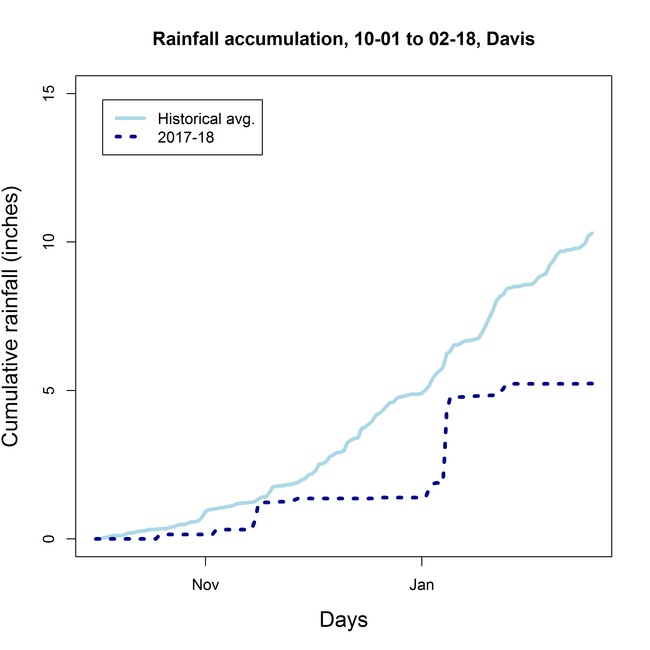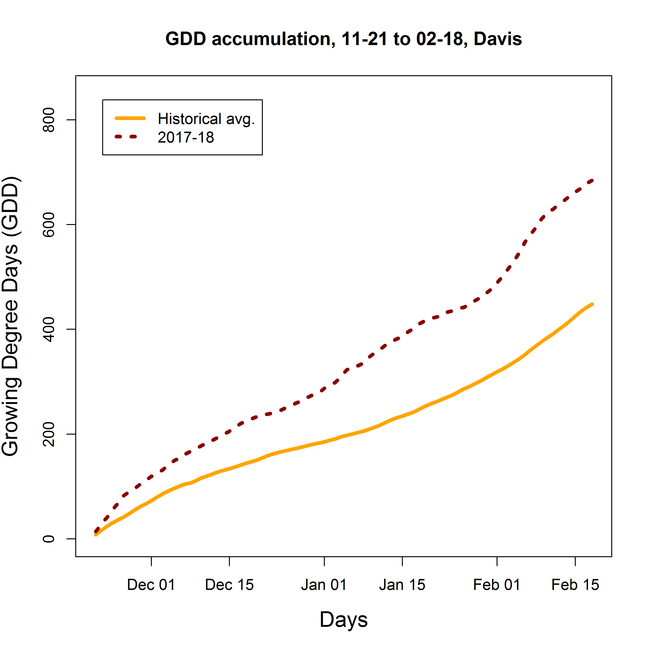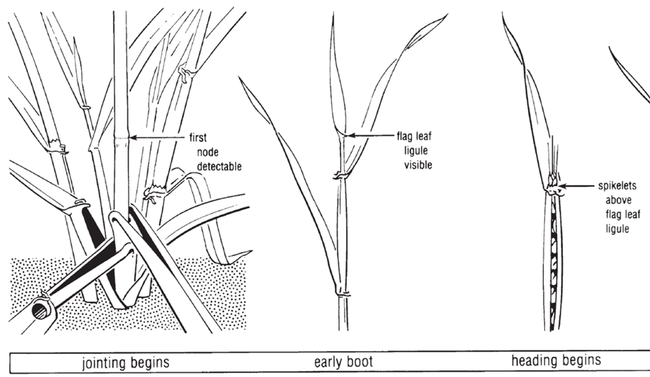After almost 6 weeks without a substantial rainstorm, there is finally some precipitation starting to appear in the 10-day forecast for the Sacramento Valley. The lack of rain thus far has made it difficult to proceed with N fertilizer topdress applications in non-irrigated wheat fields this season. In addition, the warmer than normal temperatures have increased the rate of crop development such that many fall planted wheat crops are further along than would normally be the case at this time of year. Figures 1 and 2 below represent the cumulative rainfall since 10/1/2017 and the cumulative growing degree days (GDD) for wheat since 11/21/17, when we planted our experimental trials in Davis (each is compared to a 10-year average).
Since planting, 690 GDD have accumulated at the Davis site, which puts this site near the two node stage of growth (Feekes 7) for our average spring wheat grain varieties. In previous posts on this blog, we have discussed the value of N topdress applications at the tillering/early-jointing stages of growth as well as at the late-boot/early-heading stages of growth. For information on topdress N application rates specific to these stages for average California wheat crops, please explore those posts.
For wheat crops that were planted mid-November in the Sacramento Valley this season, growers may be finding themselves between the late-jointing and early boot stages of growth at present. So how should they adjust N topdress application rates ahead of the forecast rain (hopeful that the forecast will maintain/strengthen between now then)?
Figure 3 represents wheat N uptake as a percentage of the seasonal total expressed as a function of GDD with various stages of wheat growth indicated.
As depicted by the red line, approximately 50% of N uptake has occurred by the flag leaf stage. At the transition between tillering and jointing, approximately 20% of total uptake has occurred, and approximately 70-75% of N uptake has occurred by late-boot/early heading. Therefore, a grower who normally applies a topdress of N at tillering, but has not had the opportunity to do so this season due to lack of rain, may want to account for the crop's current stage of growth. Small grain growth stages are described and illustrated in chapter 2 of the UC ANR Small Grain Production Manual, and Figure 4 (below) illustrates identifying characteristics of wheat between the early-jointing and early-heading stages of growth.
If, like our trial at Davis, your wheat crop is somewhere between 2-nodes and flag leaf and you are thinking to topdress N ahead of the storm forecast for early next week, a reduction of approximately 20-30% of your typical tillering N application rate may be appropriate to account for the difference in potential N uptake. Another factor to consider when determining whether and how much N to apply in-season is that the dry conditions this year may reduce overall crop yield potential for rainfed crops relative to a normal rainfall year. As our previous work in California has shown, wheat is responsive to N fertilizer applications during the vegetative growth stages, and an appropriately-scaled topdress of N will help crops to make the most out of a limited supply of soil water. Nevertheless, for fall-planted, rainfed wheat crops located in the Sacramento Valley this season, the factors outlined here may argue for lower overall N topdress rates than in a normal rainfall year.
As food for future thought: the use of N-rich strips can improve the precision of in-season N applications by helping to demonstrate and measure site- and year-specific differences in soil N availability, the interaction between N and water availability, and, ultimately, the likelihood of crop response to topdress N applications. See our previous post on the use of N-rich strips in combination with in-field measurements to help inform in-season N management. If you want to discuss using this approach when making a fertilization plan for small grains next season, or other aspects of this post, be sure to reach out to a UCCE agronomist in your region.



